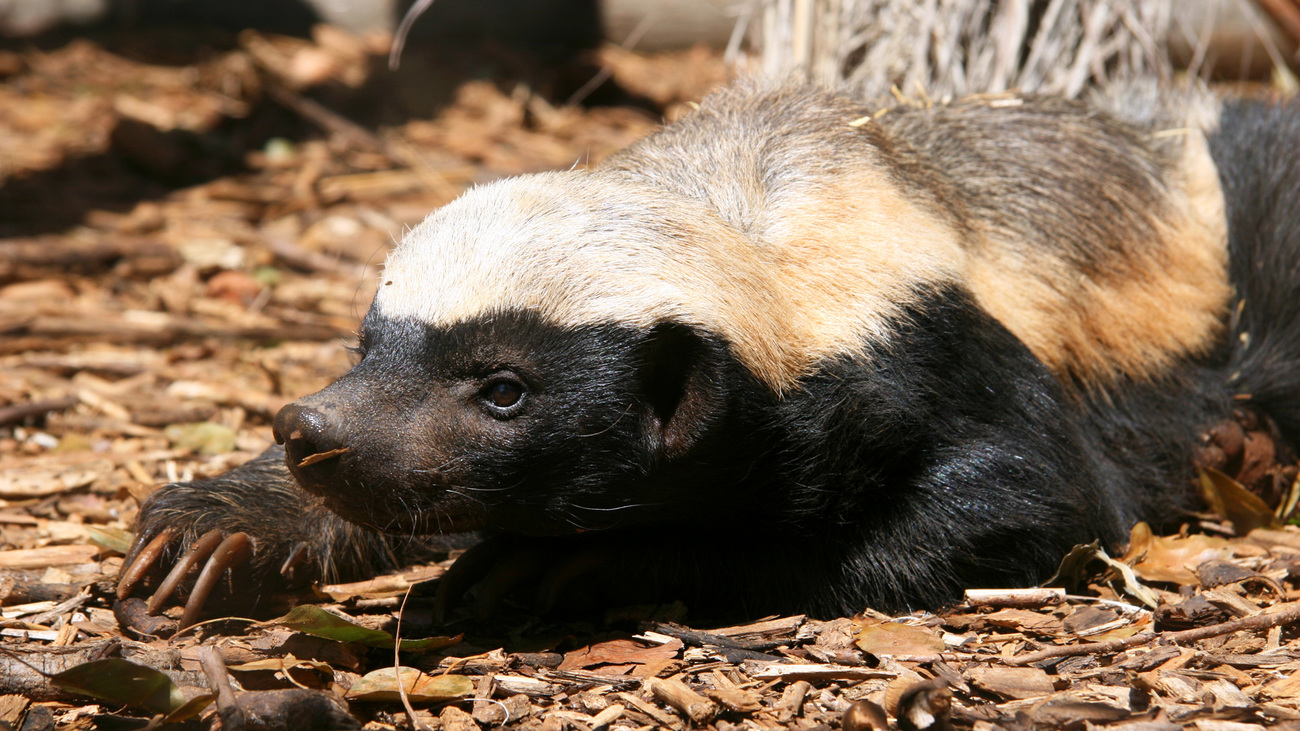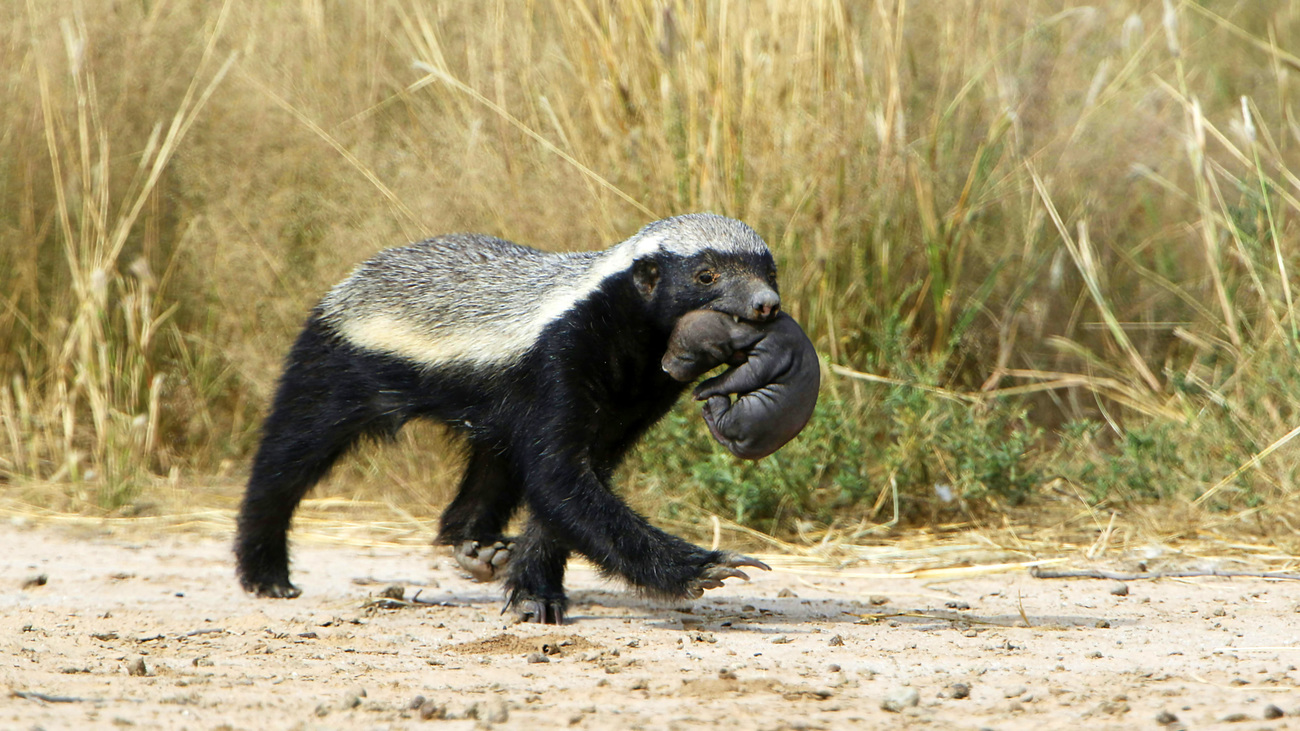Honey badgers
What is a honey badger?
Despite their name, honey badgers are members of the weasel family—though they are also related to badgers, skunks, and ferrets. Similar to the European badger, they have distinctive two-tone fur that is whitish on the top of their bodies and black on the bottom. They can reach around 100 centimeters (39 inches) in length if you include the tail and they have sharp four-centimeter-long claws (1.5 inches) that they use to dig burrows, break into honey bee nests, kill prey, and defend themselves.
Honey badgers are best known for their fearless reputation—the Guinness Book of World Records even named them the ‘most fearless animal’. You can find videos online of honey badgers staring down lions and wrestling venomous snakes out of trees. They are indeed tough. They have exceptionally loose, thick, and rubbery skin that protects them from predators’ teeth and claws and even allows them to manoeuvre their bodies while caught in their jaws to escape.
When cornered, the honey badger’s last resort is an aggressive display that involves standing up, making loud rattling grunts, and releasing a terrible-smelling scent, much like a skunk. This stand-off is often observed between honey badgers and one of their biggest predators, lions. It has led to misinformation claiming that honey badgers can fight or even kill lions, but this isn’t true. Honey badgers stand their ground and do their best to intimidate predators when they have nowhere else to run—and sometimes they can survive the encounter—but they don’t attack lions and could never kill one.
As their common name suggests, honey badgers have a fondness for honey. It’s not their main source of food, but they are prone to raiding bee nests. Aside from honey, they also eat small mammals, reptiles, invertebrates, roots, fruits, and berries. They hunt at night and cover large distances, typically alone but sometimes with a mating partner. Honey badgers can reproduce at any time of year and often have just one cub at a time.
Because they’re omnivorous and eat so many different things, honey badgers play an important role in controlling the populations of different species in their ecosystem. They even play their part in keeping carnivores competitive and vigilant by stealing food from under the noses of less watchful individuals. And, as prey animals themselves, they also help feed bigger animals like lions and leopards—though they’ll put up a good fight beforehand.
What is a honey badger’s scientific name?
The scientific name of the honey badger is Mellivora capensis. It is the only living member of the Mellivorinae subfamily—a name that originates from the Greek word for honey, meli, and the Latin word for devour, vora.
Honey badgers are also known as ratel, a term which may have been coined by Dutch settlers in South Africa because of the loud rattling sounds honey badgers make when they’re aggressive.
Are honey badgers endangered?
Honey badgers have a low population density because they typically live alone, have large home ranges, and are spread across an extremely large amount of land. The IUCN classified them as least concern in 2015, but their population is decreasing.
Where do honey badgers live?
Honey badgers live across the entirety of sub-Saharan Africa. They can also be found in Saudi Arabia, Iran, and parts of western Asia. Thanks to their omnivorous diet and ability to dig burrows wherever they live, they can adapt to a variety of habitats. This includes rainforests, arid deserts, sand deserts, clay deserts, grasslands, and mountains. They can be found at sea level and at elevations of up to 4,000 meters (13,120 feet), as well as anywhere in between.
Their home ranges can be as vast as 500 square kilometers (193 square miles) and they can travel as much as 24 to 32 kilometers (15 to 20 miles) in 24 hours. When they need to rest, they simply use their powerful arms and claws to dig a shallow burrow and stay hidden from predators.
Threats
Honey badgers are threatened by the bushmeat and traditional medicine trades, as well as human-wildlife conflict.

Bushmeat and traditional medicine
Because of their famed fearlessness and bravery, honey badgers are hunted for their paws, organs, fat, and skin, which are used in traditional medicine to bestow these properties on the user. They are also intentionally hunted as bushmeat and accidentally caught in traps laid for other species.
Human-wildlife conflict
Honey badgers have a large range and often come across human-kept bee colonies, which they will attack in search of honey. When this happens, it causes conflict with the farmers and apiculturists. To prevent honey badgers from harming their livelihoods, humans use steel-jawed traps and poisons to kill them.
Honey badgers are also killed accidentally by traps and poisons laid out for other animals, such as jackals and caracals.
FAQs
What do honey badgers eat?
Honey badgers hunt at night, preying on invertebrates like scorpions, worms, and termites, as well as larger animals such as porcupines, snakes, rabbits, and turtles. As omnivores, they also eat fruits, roots, bulbs, berries, and honey.
They also have a reputation for stealing food from other animals, like grabbing a rodent right from the jaws of a snake. When a larger predator is done with its meal, honey badgers sometimes scavenge the remains.
Do honey badgers eat honey?
Honey badgers got their name because they also eat honey. To get their fill of honey (and the honey bee larvae found in the nests), honey badgers follow a small bird called the honeyguide or indicator bird.
These birds are known for seeking out humans and guiding them to bee colonies so that they can harvest the honey, and in return, the honeyguides can eat the beeswax and grubs that are left behind in the broken nest. Stories suggest that they also work with honey badgers in the same way, though there is a lack of evidence to verify this.
However, even if the honeyguides don’t seek out honey badgers intentionally, they do still sit by nests and make calls. The honey badgers can follow these calls to find the nest and achieve the same result.
Where are honey badgers found?
Honey badgers live throughout sub-Saharan Africa and as far north as Morocco and Algeria on the African continent. They can also be found in most of the Arabian peninsula, the Middle East, Iran, Pakistan, and India. Their range extends as far north as Turkmenistan, Kazakhstan, and Uzbekistan in Asia.
How big are honey badgers?
Honey badgers are similar in size to European badgers. They stand around 30 centimeters (12 inches) tall at the shoulders, with a body length of 60 to 77 centimeters (24 to 30 inches). They have a stocky build with strong front paws and long claws for digging and breaking into nests. Their tails are around 20 to 30 centimeters (8 to 12 inches) long. Males tend to be significantly larger than females.

Why are honey badgers so tough?
Honey badgers have amazingly thick skin, around 6 to 8 millimeters (0.25 to 0.31 inches). This might not sound that impressive, but it’s exceptionally thick for their size. If you scaled a honey badger up to the size of a buffalo (another animal known for its thick skin), the honey badger’s skin would be thicker.
Their skin is also tough, rubbery, and very loose on their bodies, so they have a better chance of manoeuvring themselves out of the jaws of predators. When they manage this successfully, the predator is left with nothing but rubbery skin in their mouth and the badger can twist its body around and claw at its attacker.
Are honey badgers immune to venom?
Venomous snakes make up a large part of the honey badger’s diet (up to 25% of it), and while not immune, they do have some resistance to neurotoxic venoms—similar to that found in the domestic pig, hedgehog, and mongoose. According to studies, the resistance is achieved by preventing venom from reaching the cells it would attack.
This capability has allowed honey badgers to survive bites from highly venomous species like puff adders—and it contributes to their reputation as some of the toughest animals on Earth.
Can honey badgers kill lions?
Honey badgers cannot and do not kill lions. This rumour is just a product of the honey badger’s fearless reputation. Honey badgers are preyed on by lions and will do their best to avoid them.
When a honey badger finds itself cornered, however, its only choice is to try and scare the predator off. This is why footage can be found of honey badgers standing in front of lions and showing displays of aggression.
Do honey badgers have predators?
It’s not just lions that prey on honey badgers. Other large mammals such as leopards, hyenas, pythons, black-backed jackals, and crocodiles eat honey badgers, too.
How can you help?
Protecting wildlife around the world is what IFAW does. Learn more about how you can help protect endangered species or how you can get involved with our work.